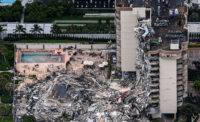Codes and Standards
First US Standard on Disproportionate Collapse Coming Soon

Investigators are considering the possibility of a disproportionate collapse at the Champlain Towers South condo in Surfside, Fla., which partially collapsed on June 24 and was razed on July 4.
Photo courtesy the Miami-Dade Fire Rescue
This summer, the Structural Engineering Institute of the American Society of Civil Engineers expects to release, for public comment, a draft of the first U.S. consensus standard addressing disproportionate collapse of structures. The ASCE-SEI Disproportionate Collapse Mitigation of Building Structures Standard Committee, which has nearly 50 members, started work on the standard in 2009, according to Donald O. Dusenberry, consulting engineer and committee chair.
“We started from scratch,” says Dusenberry, who retired in January after 45 years with Simpson Gumpertz & Heger. “I don’t believe there is anything like this in the U.S.,” he adds.
The public comment period will be open for a minimum of 45-days, per ASCE rules. The plan is to publish the standard next year.
Standard Defines Disproportionate Collapse
The draft of the standard defines disproportionate collapse as “characterized by a pronounced disparity between the original cause and the ensuing collapse of a major part or the whole of a structure.”
The timing of the release of the draft is unrelated to the June 24 partial progressive collapse of the 12-story Champlain Towers South residential condominium in Surfside, Fla. Investigators, who say it could take years to pinpoint the original cause of the failure, also are probing whether the debacle fits the definition of a disproportionate collapse.
The still-standing wing of the L-in-plan building, completed in 1981, was razed by implosion on July 4. There are at least 95 dead and 4 people unaccounted for.
The draft standard is written to coordinate SEI technical activities and the activities of material-specific guidance organizations, among them the American Concrete Institute, the American Institute of Steel Construction and the American Iron and Steel Institute.
Risk Assessment and Performance Criteria
The draft has chapters on risk assessment, performance criteria, design and analysis approaches, acceptance criteria, structural detailing, existing structures and performance qualifications.
There are at least two strategies used to engineer a structure to minimize the likelihood of disproportionate collapse, says Dusenberry. One postulates the removal of one or several significant elements, such as columns, and the development of alternate load paths.
Another is to isolate different structural systems, perhaps through expansion joints or other means. That strategy may be most useful in a long, low building, where the failure might propagate horizontally, says Dusenberry.







